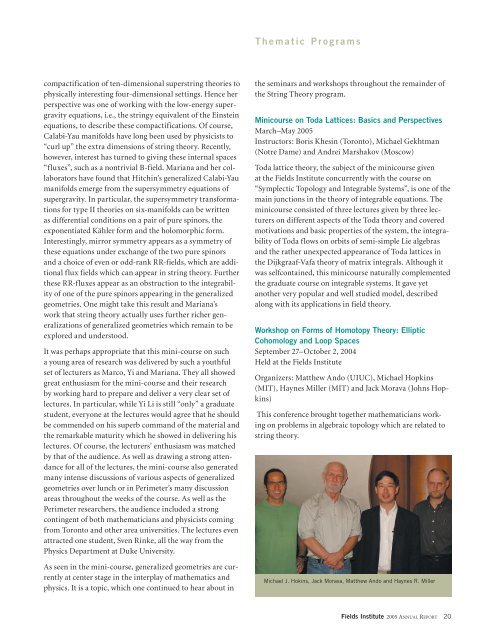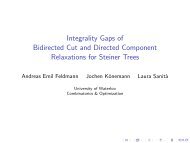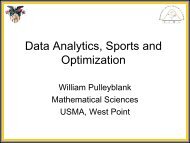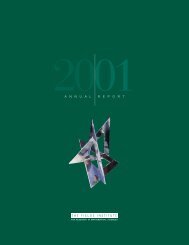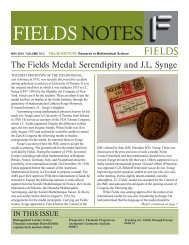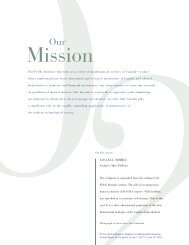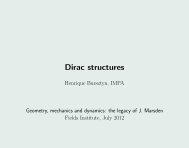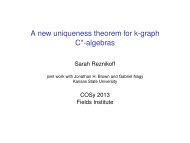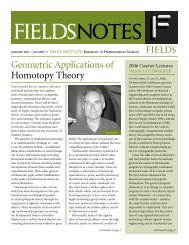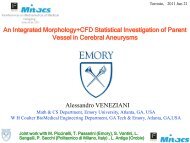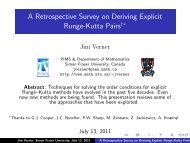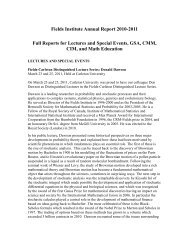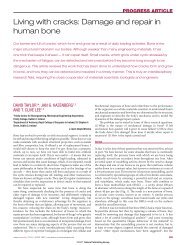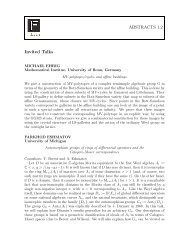Annual Report 2005 - Fields Institute - University of Toronto
Annual Report 2005 - Fields Institute - University of Toronto
Annual Report 2005 - Fields Institute - University of Toronto
You also want an ePaper? Increase the reach of your titles
YUMPU automatically turns print PDFs into web optimized ePapers that Google loves.
compactification <strong>of</strong> ten-dimensional superstring theories to<br />
physically interesting four-dimensional settings. Hence her<br />
perspective was one <strong>of</strong> working with the low-energy supergravity<br />
equations, i.e., the stringy equivalent <strong>of</strong> the Einstein<br />
equations, to describe these compactifications. Of course,<br />
Calabi-Yau manifolds have long been used by physicists to<br />
“curl up” the extra dimensions <strong>of</strong> string theory. Recently,<br />
however, interest has turned to giving these internal spaces<br />
“fluxes”, such as a nontrivial B-field. Mariana and her collaborators<br />
have found that Hitchin’s generalized Calabi-Yau<br />
manifolds emerge from the supersymmetry equations <strong>of</strong><br />
supergravity. In particular, the supersymmetry transformations<br />
for type II theories on six-manifolds can be written<br />
as differential conditions on a pair <strong>of</strong> pure spinors, the<br />
exponentiated Kähler form and the holomorphic form.<br />
Interestingly, mirror symmetry appears as a symmetry <strong>of</strong><br />
these equations under exchange <strong>of</strong> the two pure spinors<br />
and a choice <strong>of</strong> even or odd-rank RR-fields, which are additional<br />
flux fields which can appear in string theory. Further<br />
these RR-fluxes appear as an obstruction to the integrability<br />
<strong>of</strong> one <strong>of</strong> the pure spinors appearing in the generalized<br />
geometries. One might take this result and Mariana’s<br />
work that string theory actually uses further richer generalizations<br />
<strong>of</strong> generalized geometries which remain to be<br />
explored and understood.<br />
It was perhaps appropriate that this mini-course on such<br />
a young area <strong>of</strong> research was delivered by such a youthful<br />
set <strong>of</strong> lecturers as Marco, Yi and Mariana. They all showed<br />
great enthusiasm for the mini-course and their research<br />
by working hard to prepare and deliver a very clear set <strong>of</strong><br />
lectures. In particular, while Yi Li is still “only” a graduate<br />
student, everyone at the lectures would agree that he should<br />
be commended on his superb command <strong>of</strong> the material and<br />
the remarkable maturity which he showed in delivering his<br />
lectures. Of course, the lecturers’ enthusiasm was matched<br />
by that <strong>of</strong> the audience. As well as drawing a strong attendance<br />
for all <strong>of</strong> the lectures, the mini-course also generated<br />
many intense discussions <strong>of</strong> various aspects <strong>of</strong> generalized<br />
geometries over lunch or in Perimeter’s many discussion<br />
areas throughout the weeks <strong>of</strong> the course. As well as the<br />
Perimeter researchers, the audience included a strong<br />
contingent <strong>of</strong> both mathematicians and physicists coming<br />
from <strong>Toronto</strong> and other area universities. The lectures even<br />
attracted one student, Sven Rinke, all the way from the<br />
Physics Department at Duke <strong>University</strong>.<br />
As seen in the mini-course, generalized geometries are currently<br />
at center stage in the interplay <strong>of</strong> mathematics and<br />
physics. It is a topic, which one continued to hear about in<br />
T h e m a t i c P r o g r a m s<br />
the seminars and workshops throughout the remainder <strong>of</strong><br />
the String Theory program.<br />
Minicourse on Toda Lattices: Basics and Perspectives<br />
March–May <strong>2005</strong><br />
Instructors: Boris Khesin (<strong>Toronto</strong>), Michael Gekhtman<br />
(Notre Dame) and Andrei Marshakov (Moscow)<br />
Toda lattice theory, the subject <strong>of</strong> the minicourse given<br />
at the <strong>Fields</strong> <strong>Institute</strong> concurrently with the course on<br />
“Symplectic Topology and Integrable Systems”, is one <strong>of</strong> the<br />
main junctions in the theory <strong>of</strong> integrable equations. The<br />
minicourse consisted <strong>of</strong> three lectures given by three lecturers<br />
on different aspects <strong>of</strong> the Toda theory and covered<br />
motivations and basic properties <strong>of</strong> the system, the integrability<br />
<strong>of</strong> Toda flows on orbits <strong>of</strong> semi-simple Lie algebras<br />
and the rather unexpected appearance <strong>of</strong> Toda lattices in<br />
the Dijkgraaf-Vafa theory <strong>of</strong> matrix integrals. Although it<br />
was selfcontained, this minicourse naturally complemented<br />
the graduate course on integrable systems. It gave yet<br />
another very popular and well studied model, described<br />
along with its applications in field theory.<br />
Workshop on Forms <strong>of</strong> Homotopy Theory: Elliptic<br />
Cohomology and Loop Spaces<br />
September 27–October 2, 2004<br />
Held at the <strong>Fields</strong> <strong>Institute</strong><br />
Organizers: Matthew Ando (UIUC), Michael Hopkins<br />
(MIT), Haynes Miller (MIT) and Jack Morava (Johns Hopkins)<br />
This conference brought together mathematicians working<br />
on problems in algebraic topology which are related to<br />
string theory.<br />
Michael J. Hokins, Jack Morava, Matthew Ando and Haynes R. Miller<br />
<strong>Fields</strong> <strong>Institute</strong> <strong>2005</strong> ANNUAL REPORT 20


